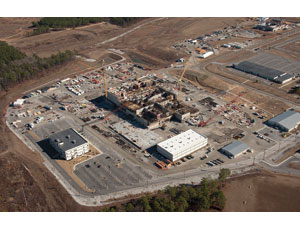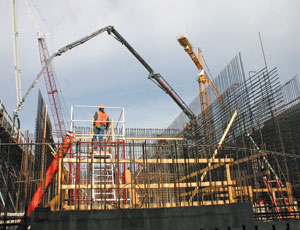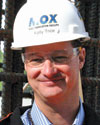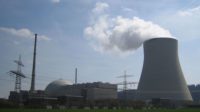It’s a structure built to precise construction standards, in some cases to a tolerance of 1/16 in.—no small feat in a structure with 80 miles of piping, 170,000 cu yd of concrete and 35,000 tons of reinforcing steel. It’s also a building that could provide a use for spent nuclear-powerplant waste, help lower energy bills and even end nuclear proliferation.


There have been some missteps in construction of the $4.8-billion Mixed Oxide Fuel Fabrication Facility in Aiken, S.C., but more than two years into the project, joint-venture partners The Shaw Group Inc., Baton Rouge, La., and French nuclear specialist Areva Inc., Paris, have kept construction on time and on budget. A U.S. commission on nuclear waste toured the project, which is based on similar French technology to recycle spent uranium, earlier this month.
The joint venture, Shaw Areva MOX Services LLC, is owned 70% by The Shaw Group and 30% by Areva. The group has a three-phase government contract to design, construct and test the facility, operate it for 20 years and then demolish it in the mid-2030s.
The MOX facility, at the U.S. Energy Dept’s Savannah River site, was commissioned by DOE’s National Nuclear Security Administration as part of a 2000 agreement between the U.S. and Russia in which both countries agreed to dispose of 34 metric tons of surplus weaponsgrade plutonium. Construction began in August 2007, with completion set for 2016, although builders are pushing to move that date up by 16 months, says Kelly Trice, the joint venture’s president and chief operating officer.
The structure is as lofty as its aspirations. The 600,000-sq-ft, five-story building is in two parts: Plutonium will be separated from other materials, with acid in one section, while the purified plutonium oxide will be made into 70,000 pellets a day to fuel nuclear plants in the second part. Between 60% to 70% of the work will be automated. The rest will be performed through glove boxes to protect workers from radiation.
Structural work is about 65% complete. Work began with a 25-ft-deep excavation that required crews to move two million cu yd of earth and install a 6½-ft-deep concrete pad. For each wall, four layers of reinforcing steel are installed—in some places it is so thick that daylight is barely visible—with concrete forms in place over the rebar. The average wall in the building is 10 ft thick.
The job is complicated further by the installation of dozens of processing tanks. Each tank has 20 to 30 connecting pipes that must be installed at precise angles to allow the gravity-fed processing system to work. About 30,000 stainless-steel panels are placed throughout the building to secure equipment for the plant’s 294 processing systems, with one system as large as a jet plane.
“It’s kind of an erector set—wall by wall, floor by floor—with a lot of engineering behind it,” says Trice. About 80% of facility design has been completed, but 650 to 700 engineers still work on the building, half on process engineering. The facility is based on Areva’s French design but had to be modified for U.S. regulations and to meet a seismic benchmark of magnitude 8.2. About 2,000 people work on-site, but the project supports an additional 2,000 jobs worldwide, Trice says. Eleven of 18 planned buildings are complete, including three that have attained Leadership in Environmental Energy Design Gold status, builders say.
Two U.S. Nuclear Regulatory Commission inspectors are on-site at all times. “The expectation is that the plant will be built perfectly without defects,” Trice says. Inspectors cited Shaw Areva recently for design problems. “We want them to continue to be vigilant in that area,” says NRC spokesman Roger Hannah. Before operations can begin, the agency must verify that Shaw Areva’s principal structures, systems and components pass muster.

TRICE
Shaw Areva builds in its own inspections. “You need to find everything before the NRC does,” Trice says. The contractor’s inspectors in 2008 discovered that its rebar vendor, Energy and Process Corp., Tucker, Ga., had supplied steel rods with a bend radius below the minimum specified for nuclear construction by the American Concrete Institute.
A small amount already used in construction was deemed safe and left in place. The contractor returned the remaining 1,000 tons of rebar. Shaw Areva has had no problems since switching vendors, NRC officials say. The agency issued the project’s final safety evaluation report last month, stating that facility operations would not post undue risk to workers or the public.
Despite the complexities of engineering and construction, Trice and Clay Ramsay, DOE’s MOX project director, say the most difficult part of the job has been finding qualified equipment and materials suppliers. Since the facility was the first nuclear construction begun in two decades, the nuclear supply chain had almost dried up. Trice says that, in some cases involving certain components, there were no bid responders, forcing site companies to manufacture needed parts themselves. Ramsay says the pioneering project has faced other struggles and hurdles. “It’s very complex because it’s the first of its kind,” he says.
Some members of Congress, initially upset with project costs, tried to stop the plant, while activist groups— such as the Union of Concerned Scientists—moved to bar construction in part because the concentration of weapons-grade material on-site could be a terrorist target.
Finding customers for the reprocessed fuel has been a challenge. Duke Energy, which had a contract for the MOX fuel, decided in 2009 not to use the MOX fuel at its plants after a trial with reprocessed plutonium from France showed abnormalities. The Tennessee Valley Authority has since stepped in, announcing last year in an agreement with NNSA that it will pursue use of the recycled plutonium at some plants. “We are primarily looking at that as a cost benefit to our customers — lower, stable fuel prices. We believe it is safe fuel to use,” says Jack Bailey of TVA. “It’s a leadership issue, too. We want to help move this country forward.”


Post a comment to this article
Report Abusive Comment